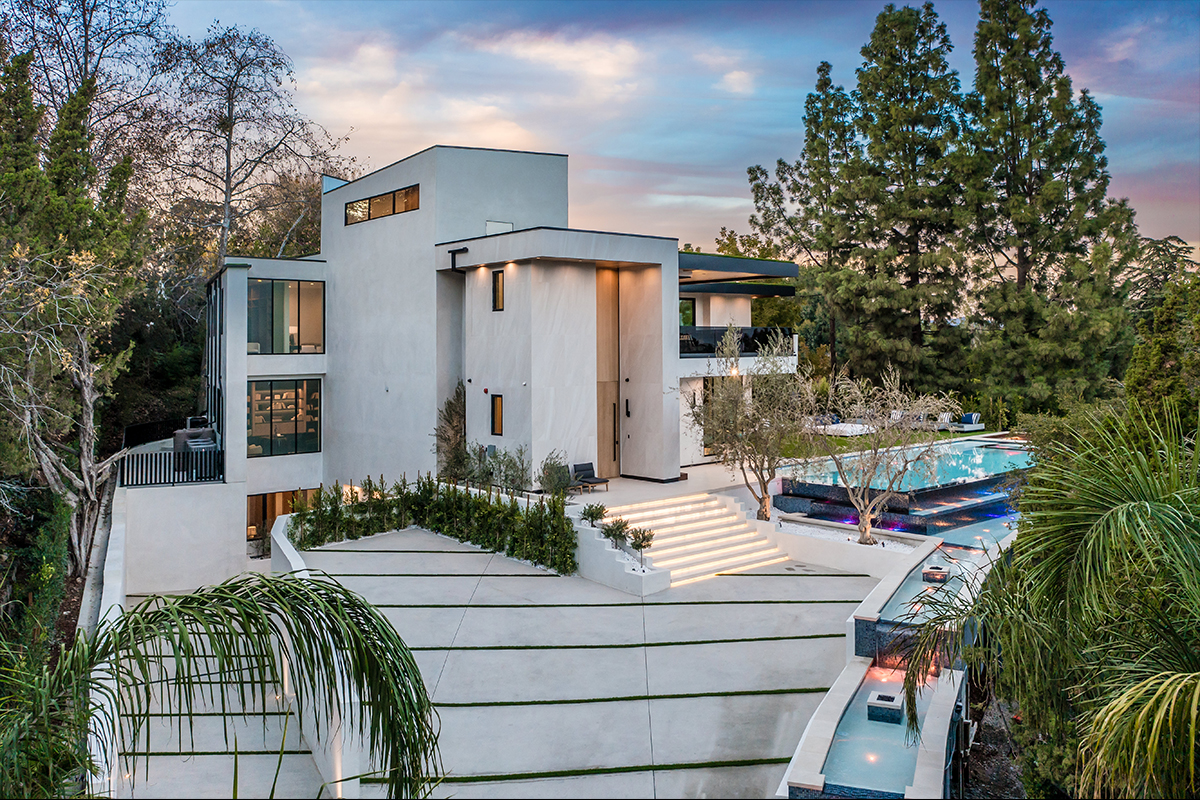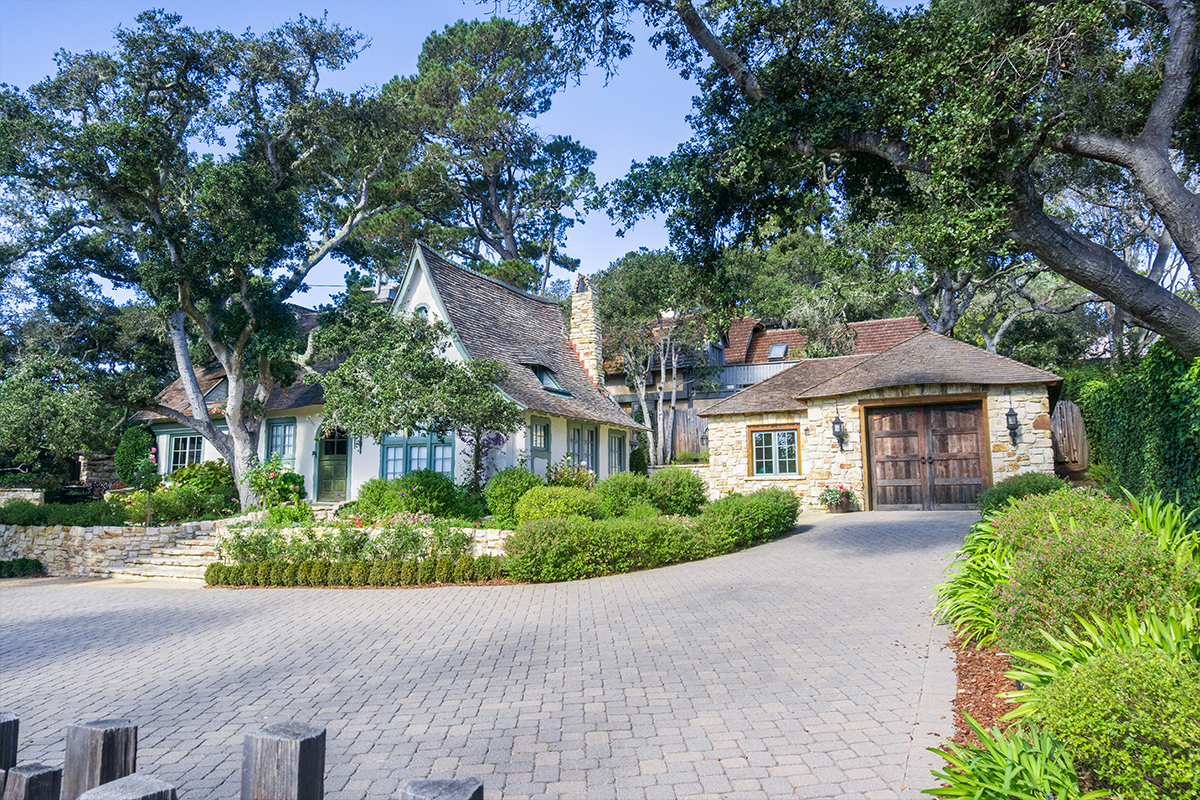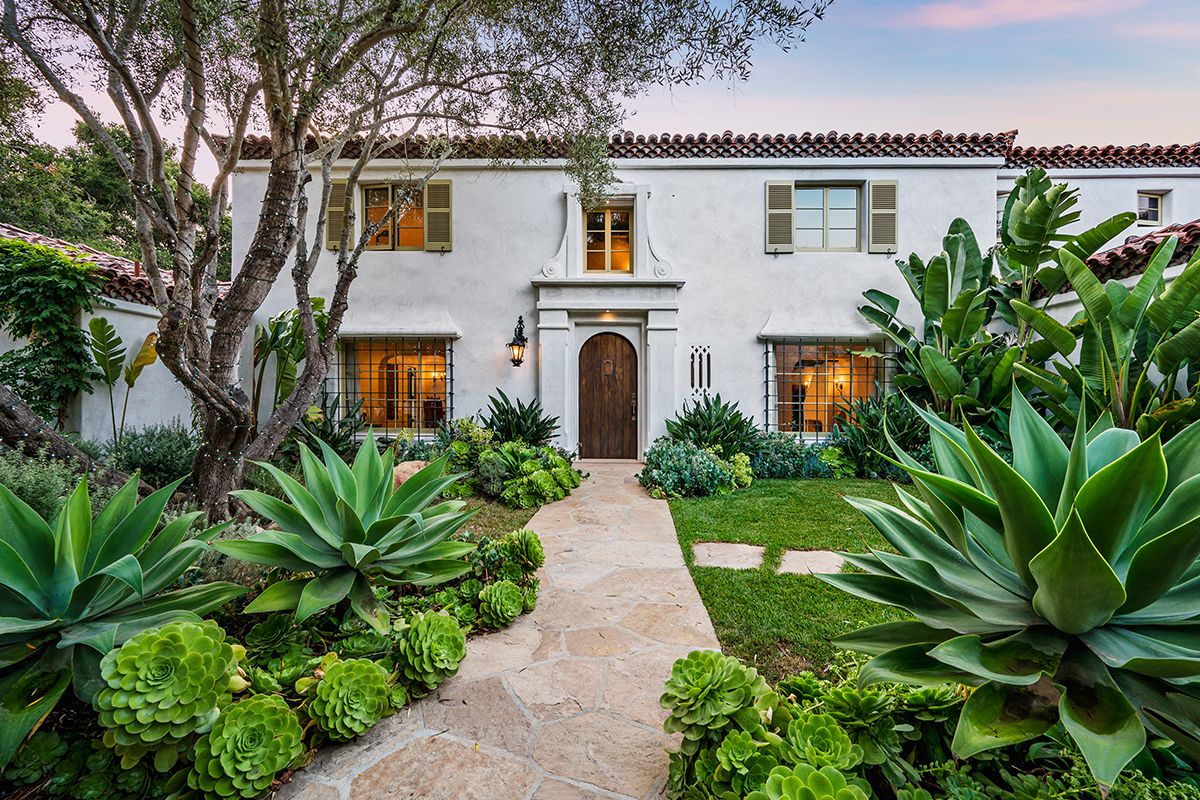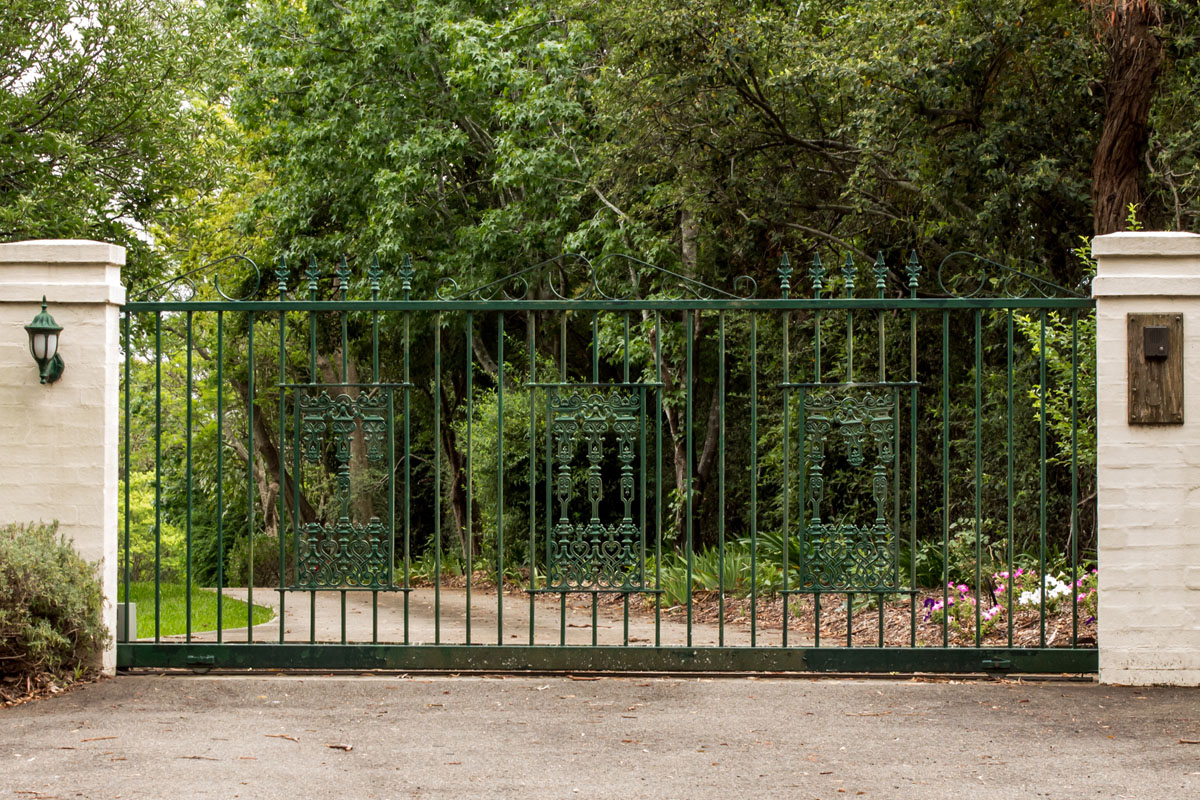The art of arrival: Designing driveways and entryways that impress

Clean architectural lines, ambient lighting, and a sculptural front door set the stage for an unforgettable arrival.
In the world of luxury real estate, arrival is more than a moment—it’s a statement. That first impression, as tires kiss a cobbled drive or a gate glides open with a hushed elegance, sets the tone for everything that follows. The luxury home entryway isn’t just a threshold; it’s the opening line to a home’s story.
Over the years, I’ve seen firsthand how this “arrival moment” has evolved into an art form in Beverly Hills, where properties are also legacy investments. A well-designed entry shapes one’s perception and, more often than expected, influences resale value. After all, few features leave a more lasting impression.
Table of Contents:
THE EVOLUTION OF THE ENTRY EXPERIENCE
Before the luxury home entryway became an art form, it was purely functional. Doors simply served as gateways to another room or space, while driveways were places to park a vehicle—nothing more, nothing less.
Over time, with development and increased purchasing power, people found ways to add flourishes to these practical aspects. What once marked a boundary became a moment of arrival, setting the stage for the lifestyle within.
The American evolution: from suburbia to statement
In early American architecture, entryways were modest and utilitarian. Colonials and farmhouses featured straightforward walkways and front stoops, focused more on function than impression. That changed during the Gilded Age, however, when wealthy industrialists embraced the aesthetics of European aristocracy, incorporating features such as sweeping drives, ornate gates, and formal arrival courts into their homes.
In California, the postwar boom ushered in the mid-century modern movement, favoring clean lines and minimalism. Even so, the entry retained symbolic weight. Architects like Richard Neutra and John Lautner elevated the experience with floating steps, carports, and dramatic sightlines that choreographed how guests approached the home.
Today’s luxury home entryway: Privacy, presence, and personalization
By the late 20th century, as Beverly Hills emerged as a global symbol of wealth and celebrity, the luxury home entryway evolved once again. Privacy, performance, and personality became just as important as visual impact.
This is made possible with today’s technology. Gates may recall 18th-century ironwork, but operate with biometric scanners and silent motors. A driveway might channel the charm of a Tuscan vineyard yet be heated, self-draining, and illuminated by motion sensors hidden in the landscape. The end result is an entry that’s timeless and intelligently engineered, built to impress and designed to function at the same time.
THE ESSENTIAL ELEMENTS OF A LUXURY HOME ENTRYWAY
The most memorable luxury home entryways aren’t defined by a single feature; they’re the result of layered design choices that shape a powerful sense of arrival. From the first glimpse of the gate to the moment you step through the front door, each element plays a role in signaling prestige, privacy, and permanence.
Here are the key components that elevate an entry—and how you can incorporate them into your property.
The gate: where first impressions begin
The gate is the first architectural gesture your property makes, a defining threshold that sets the tone for everything beyond. And in Beverly Hills luxury real estate, it’s not just about privacy or security; it’s a canvas for creativity, symbolism, and innovation.
Today’s luxury home entryway often begins with a gate that’s as thoughtfully designed as the residence itself. It offers a moment of pause, a sense of ceremony, and increasingly, a glimpse into the homeowner’s style and priorities.
- Materials that speak volumes: We’re seeing a renaissance in gate materials. Forged iron remains a timeless classic, especially when paired with stone columns or traditional façades. But newer trends lean into architectural bronze, brushed stainless steel, powder-coated aluminum, and even charred wood for a more contemporary aesthetic.
Glass and acrylic inserts are gaining popularity for minimalist homes, offering privacy without sacrificing light or visual openness. Matte black finishes are a favorite for modernist properties, while custom patinas and textured metalwork give traditional gates a refreshed look.
- Personalization with purpose: Emblems, monograms, and custom details are making a return, not as displays of excess, but as quiet declarations of identity. Etched crests, initials, or engraved insignias add heritage and meaning, while digital signatures—backlit LED house numbers, for instance—are an alternative if you prefer a modern edge.
- Art meets infrastructure: We’re seeing more gates designed in collaboration with artists and sculptors, pieces that blur the line between utility and art. Some resemble kinetic sculptures, unfolding in motion, while others integrate materials like reclaimed wood, hammered copper, or hand-blown glass.
Lighting is just as integral. Discreet LED strips, uplighting, and embedded fiber optics transform a gate after dusk. The most elegant designs avoid floodlights in favor of layered, ambient illumination that enhances texture and form without overwhelming the landscape.

Clean architectural lines, ambient lighting, and a sculptural front door set the stage for an unforgettable arrival.
- Intelligence beneath the design: Beauty aside, a stunning gate must also perform. Today’s designs often integrate smart features like biometric scanners, license plate recognition, facial recognition, and app-controlled access—all seamlessly embedded to maintain visual clarity
Even intercoms have evolved. High-resolution video, encrypted Wi-Fi, and AI-assisted visitor detection are now standard. Some systems sync with full home automation, triggering pathway lights, audio, or even climate adjustments as familiar vehicles arrive.
In short, a gate is no longer just a barrier—it’s an experience. They’re statements of taste, of innovation, and of intentionality. The gate is your first chance to shape the arrival experience and in the luxury market, that moment matters more than ever.
The driveway: setting the stage for arrival
In Beverly Hills, a driveway is never just a way in. It’s the silent conductor of the entire arrival experience, defining the flow, setting the pace, and building anticipation before a guest ever reaches the front door. Basically, the luxury home entryway begins with a driveway that’s nothing short of unforgettable.
Layouts that choreograph movement
There’s an art to how a driveway moves. Some are straight and stately; others curve slowly, delaying the reveal in all the right ways. These aren’t random paths. They’re spatial choreography, inviting movement, pausing for impact, and culminating in awe.
- Circular driveways offer symmetry, ease, and a grand, hotel-like feel. Ideal for estates with large front setbacks, they gracefully manage multiple vehicles without crowding.
- Serpentine or curved driveways meander through mature landscaping or wrap around dramatic architectural features, building suspense with every turn.
- Motor courts and auto courts combine form and function, often featuring stone or turf inlays that create a courtyard feel—an elegant pause before entry.
- Elevated driveways amplify presence. Whether gently sloped or dramatically tiered, they signal arrival with perspective and grace.
Materials that elevate the ordinary
Today’s luxury driveways do more than transport. They elevate the everyday through design and detail.
- Popular materials include exposed aggregate concrete, natural cobblestone, large-format pavers, and porcelain tile with anti-slip finishes. Meanwhile, sleek poured concrete with score joints or black basalt pavers offer minimalist appeal, especially for contemporary homes.
- Accents like grass ribbons, brass or steel inlays, and integrated lighting strips bring rhythm, texture, and identity to the surface.
Even function gets an upgrade. Heated driveways aren’t just for snowy climates. They also reduce pooling and maintenance, especially when paired with permeable materials.
Architectural drama meets sculptural elegance
Some of the most memorable luxury home entryway experiences I’ve encountered involve architectural drama such as elevation, symmetry, and scale all working together to frame the home like a work of art.
- Sculptural islands at the center of a circular drive create a focal point. These might include mature olive trees, minimalist water basins, curated bonsai collections, or even large-scale sculpture.
- Water features integrated into the drive—like reflecting pools flanking the entrance or a gentle stream beneath a glass bridge—create that desirable movement and tranquility. The subtle sound of water has a calming, almost meditative effect on arrival.
- Tiered or terraced drives are especially striking on sloped lots, creating the feeling of ascending to a sanctuary. These designs often combine retaining walls, integrated planters, and elegant handrails or lighting for both safety and style.
It’s not just about getting there; it’s about how the journey feels. Each choice shapes the emotional arc of the arrival.
Engaging the senses: light, scent, and ambiance
Here’s a modern concept: a driveway should not only be seen, it should be felt. I always advise clients to consider the multisensory experience of arrival, especially in the final moments before the front door.
- Lighting plays a crucial role. Discreet in-ground fixtures, uplights in tree wells, or lantern-style bollards can provide visibility while emphasizing texture, depth, and structure. The best lighting schemes evolve from dusk to night, revealing new layers of the landscape as the light shifts.
- Scented landscaping is a timeless but often overlooked detail. Planting lavender, jasmine, gardenia, or citrus along the approach creates an olfactory experience that lingers long after arrival. These natural fragrances become part of the home’s identity, especially in warmer months.
These sensory layers transform a driveway from a means of transportation into a moment of immersion, setting the tone for what lies inside.

The driveway is the silent conductor of the entire arrival experience.
The front door: the opening act of the interior story
If the gate is the start of the sentence, and the driveway is the body, then the front door is the punctuation mark. It announces the transition between the public and the private, from street to sanctuary. It also happens to be the most photographed element of the facade, and increasingly, it’s being treated like a work of art.
When I guide clients through homes, I always pay attention to how the front door feels. Does it draw you in? Does it make a statement? Does it honor the architecture of the home while standing proudly on its own? These are not minor questions. The front door is the handshake before the conversation, the very essence of a luxury home entryway.
A door with presence
Great doors have presence. They’re scaled to match the architecture—tall and regal for classical estates, minimalist and monolithic for modern builds. Some are dramatically oversized to amplify proportion. Others are concealed within a panel or cladded wall, revealing themselves only upon approach.
But even the subtlest doors speak volumes. Custom millwork, aged solid wood, and textured bronze with hand-applied patina are tactile choices that communicate sophistication before a word is said.
Today’s front doors are evolving into architectural masterpieces. Some of the most notable trends include:
- Pivot doors: Large-format and hardware-free, pivot doors rotate around a central axis with smooth, theatrical motion.
- Flush-mount or hidden doors: A favorite in ultra-modern homes, these blend into the wall plane with matching materials for a seamless look.
- Framed glass doors: Offering gallery-like visibility into lobbies or courtyards, these doors bring in light and a sense of openness.
- Double doors: A timeless choice for traditional homes, double doors with symmetrical detailing never go out of style.
- Arched entries and custom shapes: From Art Deco curves to Moroccan-inspired forms, these add distinctiveness and romance to the entry.
Materiality that matters
The materials you choose for your front door tell a story—of legacy, of craftsmanship, of personal taste. Some standout options include:
- Solid hardwoods like walnut, white oak, and teak are being reimagined in new ways, often with geometric paneling, deep staining, or inlays of contrasting wood or stone.
- Steel and metal doors, once purely industrial, have found their way into luxury properties thanks to advances in thermal technology and insulation. These doors are now warm to the touch, energy-efficient, and surprisingly versatile in style.
- Glass is everywhere from sandblasted privacy panels to textured, ribbed, or acid-etched treatments that soften the view without sacrificing light. In coastal or hillside properties, floor-to-ceiling glass doors can also frame incredible views.
- Bronze and brass cladding is becoming a signature look in ultra-high-end properties. These metals age gracefully, developing a natural patina that adds character over time. They pair beautifully with stone, marble, or rich wood tones.
- Stone inlay or veneer doors are emerging as a bold statement, especially on contemporary homes. These doors may use limestone, travertine, or engineered stone panels that blend with the exterior walls, creating a seamless monolithic look.
And of course, sustainability is a growing focus. Many homeowners are opting for FSC-certified woods, reclaimed materials, or energy-efficient cores that don’t compromise on aesthetics.
THE PORTICO: ELEVATING YOUR FIRST STEPS INSIDEOne other entryway element that isn’t essential but nonetheless welcome is the portico. This architectural feature—a covered entry supported by columns or piers—can be thought of as the elegant ancestor of the modern porch. The portico originated in ancient Greek and Roman architecture, often associated with formality and grandeur in neoclassical homes. It’s designed for impact, framing the front door and offering a stately, sheltered transition into the home. The modern porch, on the other hand, is more casual and often designed for lounging. |

Arrival is more than a moment—it’s a statement
MAKE A STELLAR FIRST IMPRESSION
Whether you’re considering renovations or starting from scratch, don’t underestimate the value of a luxury home entryway. It’s more than curb appeal—it’s a multisensory experience that sets the tone for everything that follows.
As a real estate professional who’s spent over four decades representing some of the most iconic estates in the world, I can tell you that arrival matters, not just emotionally, but financially. Properties with thoughtfully designed entryways command higher attention, better offers, and more enduring appeal. Buyers remember how a home made them feel, and often, that memory starts before they’ve even stepped inside.
You deserve a home with an entrance that speaks for you. Contact me, Joyce Rey, at 310.291.6646 or send a message to explore your options in Beverly Hills luxury real estate.

Browse our latest news and updates below


